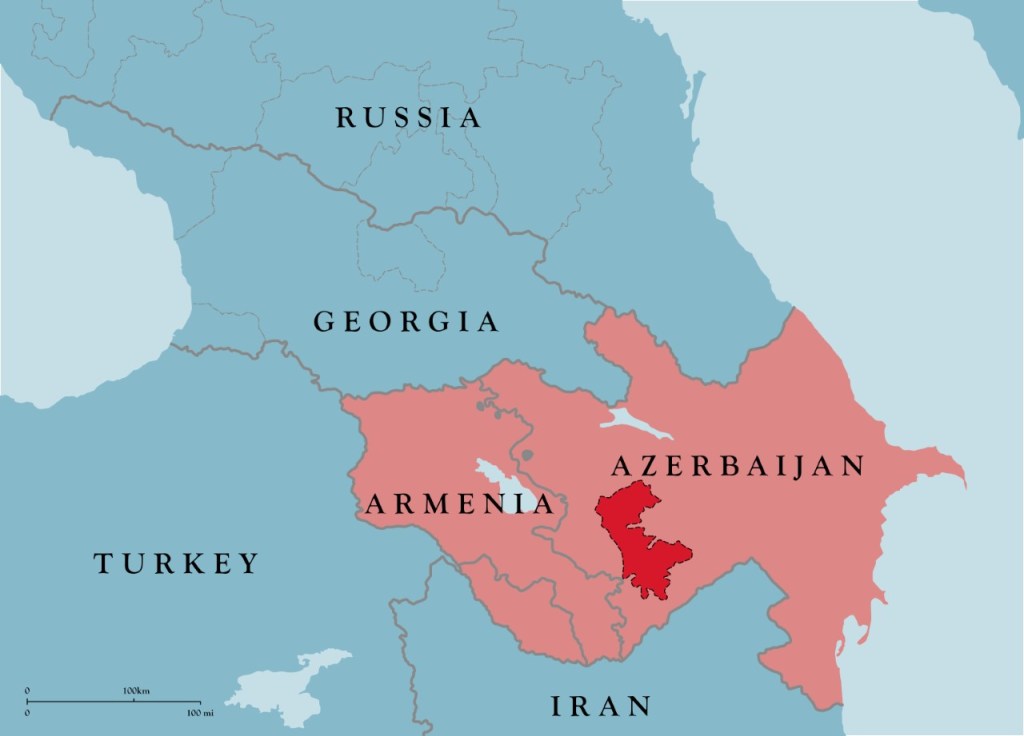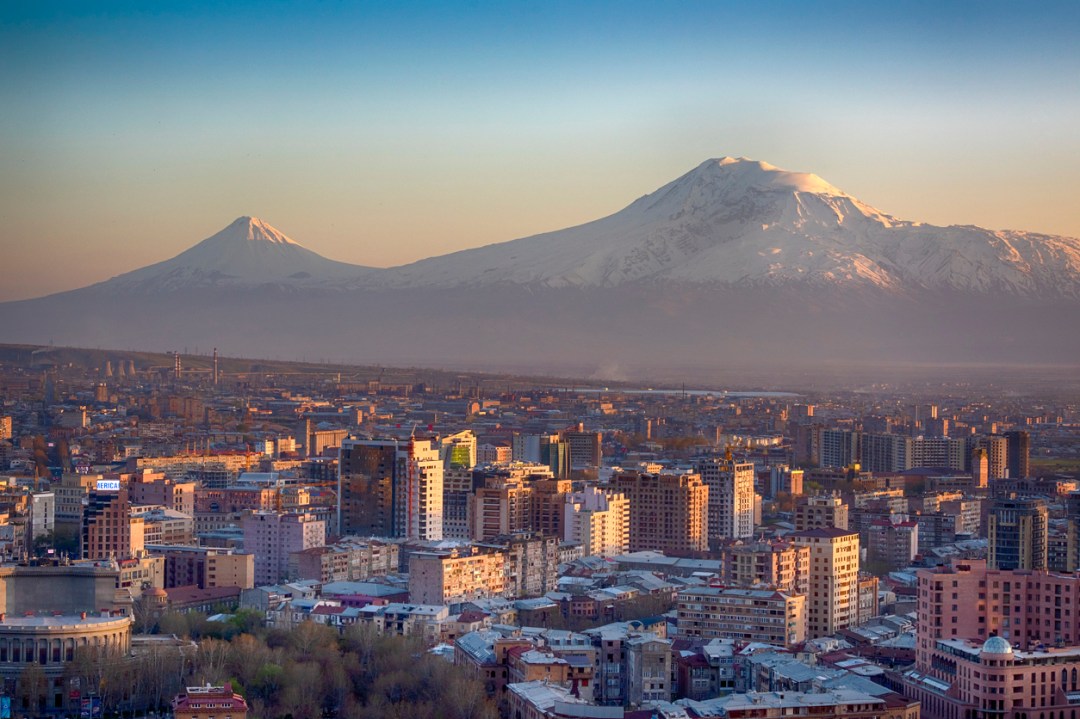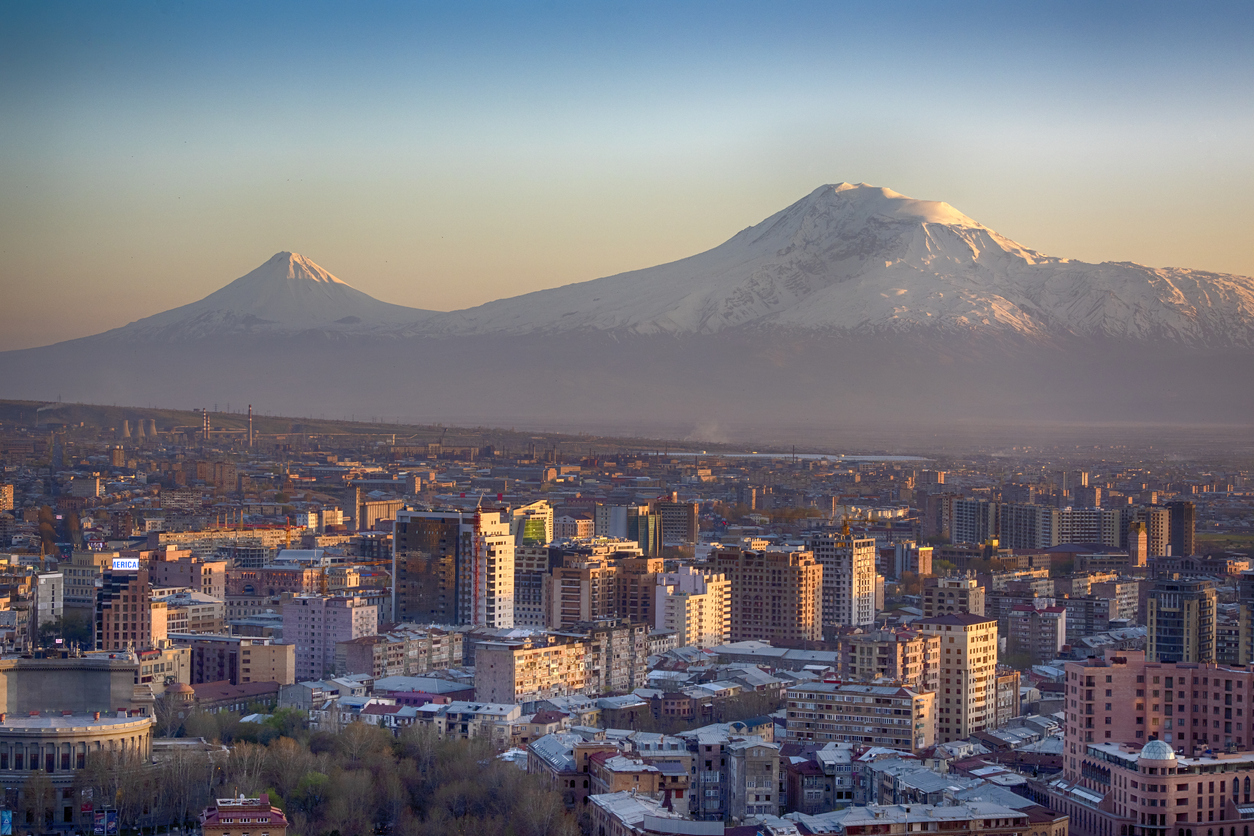Stroll around the elegant capitals of Georgia and Armenia and you could be almost anywhere in Europe. The grand boulevards, familiar luxury brands, fast-food outlets, smart restaurants and gridlocked traffic suggest that you might be in Hungary or the Czech Republic.
Only the cruciform shape of the domed and ancient churches place you elsewhere; that, and in Georgia’s Tbilisi at least, the ubiquitous anti-Russian, anti-Putin graffiti.
The Ukraine conflict has meant large numbers of Russians have arrived in Georgia – not to everyone’s delight. ‘What makes them so maddening is their arrogance,’ my hostess said one night.
‘A friend of mine lent a Russian refugee family her flat – for free. But when she went round with home baked bread to welcome them, she was told they were busy and to leave it on the kitchen table.
‘They treated her like a maid.’
Equally frustrating, apparently, is the Russian visitors’ lack of awareness that Georgia has itself suffered creeping territorial incursions orchestrated by the Kremlin. Both Abkhazia and South Ossetia – 20 per cent of the country – are now, in effect, Russian satraps following local revolts widely suspected to have been masterminded in Moscow.
It seems the Great Game – that 19th century power struggle over Asia – never ended. It just migrated west to the Caucasus, that narrow 300-mile corridor of land between the Black and Caspian seas.
The Game’s traditional battleground of Afghanistan is well over. A ragbag rabble of Mullahs has followed up whipping the British Raj with humiliations of both Russia and now the United States of America. The Chinese, the Indians and the Russians are now increasingly more willing than the West to deal with the Taliban, and therefore all these countries have expanded their influence over the Hindu Kush as the West has withdrawn.
Further into the Middle East, or Near East as the Russians call it, Moscow and Beijing appear to be dividing up the diplomatic spoils. Russia exploited the war in Syria to great effect and China just brokered a new diplomatic agreement between Saudi Arabia and Iran.
The real action, however, is over the Central Asian states – the ‘Stans’ – who are busy flirting with Beijing and need constant wooing by Putin to keep on board. Last autumn alone, Sadyr Japarov, president of Kyrgyzstan, kept Putin waiting for a meeting (a humiliation traditionally delivered vice-versa).
Not to be outdone, president Emomali Rahmon of Tajikistan chose a public meeting to unleash a seven-minute rant at the Russian leader, demanding more ‘respect’.
No wonder then that Russia’s near abroad – its creaking South Caucasus back door – is becoming a cause for Kremlin concern.
In this chapter of the Game, the personnel are changing too. Britain, for centuries a chief protagonist, is nowhere to be seen – the grizzled old Lion’s diplomats reduced to short rations and rented offices. Even the US, armed only with non-lethal aid and worthy civil society-building programmes, is not much more than a bit player.
The new kid on the block is Turkey and its Turkic cousins, the Azerbaijanis – ‘one nation in two countries’ as the ultra-nationalists like to say, as they unveil wishful maps of a Greater Turkey stretching from the Aegean to Siberia.
It is here that the balance of power is shifting like the tectonic plates under Anatolia. For though Turkey, still reeling from its recent catastrophic earthquakes, has elections imminently, Russia is nonetheless having to treat Nato’s flakiest member with kid gloves.
It was president Recep Tayyip Erdogan, after all, who first tried the keep-Putin-waiting ruse. But also, crucially, it is he who turns a blind eye to systemic busting of the West’s sanctions on Moscow while also flogging drones to Kiev.
Such two-faced pragmatism by Ankara is easier to deliver when you can back it up with an army of 425,000 and another 200,000 reserves.
All this is bad news for Armenia. To understand why you need to look at the map:

If ever there was a faraway country about which we know nothing, tiny, embattled Armenia ticks all the boxes. A little larger than Wales but with a population of just 2.8 million, it is best known for its sprawling diaspora, perhaps five times as large. There are huge overseas populations in Russia, the USA and France, and successful entrepreneurial enclaves everywhere from Mumbai to Montreal.
Most of all, the Armenians are known for the appalling 1915 bloodbath when Turks slaughtered up to 1.5 million in what many consider a pre-cursor to the Nazi Holocaust – punishment, it is supposed, for their Christian religion and mercantile success.
Today, several Armenians are more famous than their country. They include the late composer Aram Khachaturian, artist Arshile Gorky, and crooner Charles Aznavour, born Aznavourian. Contemporary celebrities number the titan art dealer Larry Gagosian, rock legend Cher, and, I am afraid, the Kardashians.
Oh yes, and brick-faced Russian Foreign Minister, Sergey Lavrov, whose Armenian father’s surname was Kalantaryan and who lived in neighbouring Tbilisi.
Armenia, which 1,700 years ago became the first Christian state, traces its mythic origins back to a grandson of Noah whose Ark shipwrecked on Mount Ararat, just over the current Turkish border. The snow-capped mountain is clearly visible from their charming, sophisticated capital, Yerevan, where trout-pouting Russian girls in pink velour track suits crowd the wine bars.
Its problems are both climatic – little water, no energy – but above all geographical. ‘Your neighbours are like your mother-in-law,’ says Loven Zoubiran, a senior opposition politician over ice-cold vodka in a Russian-run restaurant. ‘You have no choice: you have to accommodate them.’
It is little Armenia’s bad luck to live in a truculent neighbourhood. With Turkey to the west and its cousins, the Azeris, to the east, Iran to the south and Russia, looming above Georgia to the north, it was a bold move to be first to secede from the Soviet Union in 1991. It was duly punished by Russian support for Azeri incursions.
But today it is old Mother Russia who guarantees Yerevan’s security. Two thousand Russian peacekeepers stand between Armenia and its menacing Turkic neighbours, manning the closed border with Turkey itself and, in theory (but not practice) protecting the embattled 120,000 Armenians now trapped and starving in their shrinking enclave in Azerbaijan, Nagorno-Karabakh.
That dispute is about as comprehensible as Schleswig-Holstein. It centres on this mountainous outpost being granted autonomy by the USSR while existing inside Azerbaijan. This contradiction has worsened with the Azeris’ own independence. Sporadic outbursts of fighting, the last of which, in September, saw significant gains by Baku, and the closing of a transport corridor linking the enclave to Armenia.
Outnumbered, the Russian peace-keepers sat on their hands. Left to its own devices, the liberal government of Prime Minister Nikol Pashinyan would dearly love to climb straight into bed with the West. And for good reason. The three Russian television channels and social media propaganda are relentless. But when the chips are down, Yerevan always caves.
In 2013, when the then Armenian president, Serzh Sargsyan, was scheduled to go to Brussels to sign an EU cooperation and partnership deal, three years in the making, Putin picked up the phone and summoned him to the Kremlin. He leapt to attention, dumped his Brussels flight, dashed to Moscow and joined instead Russia’s Eurasian Economic Union. (A lesser pact with the EU was signed later.)
Five years later in 2018 a mass revolt, the so-called Velvet Revolution, threw Sargsyan out and ushered in Pashinyan’s more Eurocentric regime. But it lives on its nerves.
‘Whenever the government pushes back,’ Arevik Sahjakyan, a local online journalist observes, ’the Russians make us pay in some way. They realise that if they lose Armenia, they lose the whole Caucasus.’
When Azeri forces attacked its territory last autumn, Pashinyan appealed to the Collective Security Treaty Organisation (Russia’s Nato, known by cynics as the ‘Dictator’s Club’). Despite Armenia still being a member of the post-Soviet mutual defence pact – the equivalent to Nato’s Article IV – no help was forthcoming from Moscow, itself fearful of upsetting the boys from Baku.
The EU, fresh from securing Azeri gas supplies was also too far away and unable, or simply disinclined, to help. And the US? With one eye on nearby Iran and Israeli listening posts on Azeri territory, DC was also keen to stay in Azerbaijan’s Ilham Aliyev’s good books. When US Secretary of State, Antony Blinken, politely asked the Azeri president not to shut off Nagorno Karabakh’s gas supply, he was ignored.
As Richard Giragosian, the go-to Armenian American think-tanker in Yerevan, put it baldly to me: ‘It’s not a John Wayne movie – there is no cavalry coming.’
Armenia is not without friends in the US. The country reputably has the second-most powerful lobby in Washington DC after Israel. Moreover, Nancy Pelosi, until January speaker of the House of Representatives, has the largest Armenian community in America in her Californian congressional district. She dropped by in solidarity last year.
But look at the map again. It is too small and there are bigger local fish to fry. What can you do?
What is more, even the unwelcome but necessary Russian peacekeeping operation is unreliable. Putin’s Ukraine adventure has drained power away from Russia to the other actors. Given the precedent – if territorial conquest is now an option – why shouldn’t 10 million-strong Azerbaijan take a bite out of its little neighbour to unite with its own enclave in Armenia’s west and thereby establish a solid land route to Mother Turkey?
So what’s to become of the South Caucasus? The only certainty is continued nervous insecurity. Until now, 70 years of authoritarian rule by the USSR had at least ensured relative peace. Now Russia’s ‘special military operation’ has made territorial adventures by others less improbable than they were.
The two Christian leftovers of the Soviets’ southern empire – Georgia and Armenia – find themselves in a tug of war not just between Russia and the West, but also with the Turkic world to its east and west.
Both countries appear to have adopted differing survival strategies. The Georgians, many of them pining unrealistically for EU and even Nato membership, find their own government overly attentive to Moscow’s interests. Some now fear that the governing Georgian Dream party is merely reverting to type: the old authoritarian/oligarchic model so loved by Russia.
In Armenia, the political struggle is between a government taking baby steps towards democracy – freedom of speech, judicial reforms – and those, as Hilaire Belloc might put it, clinging on to the Russian nurse for fear of something worse.
A Russian initiative that would allow the Azeris a road and rail corridor to their own enclave in the west of Armenia is currently at the heart of peace talks. It would be guarded by Russian peacekeepers, supervised, some say, by the FSB.
‘If they get that we would lose our country entirely,’ a pro-western Armenian journalist told me, insisting nervously that her name not be used.
Over the past year, a tide of young Russian talent – IT professionals and middle-class draft avoiders – has flooded into the country, boosting GDP last year by an astonishing 14 per cent. In Yerevan’s affluent city centre, it feels things are not all bad.
But other vultures are circling too. Now even the Indians are supplying the Armenians with weapons and have ambitious plans to drive a trade corridor to Europe from the Iranian port of Chabahar, through Armenia to the Black Sea.
‘Their aim too is to counter Pakistan’s alliance with the Azeris,’ Zoubiran warily observes. ‘Everyone wants to play, and Armenia has become the focus of the competition between the Great Powers.’
If further evidence were needed, it can be found on the dusty, traffic-clogged road out to the airport. There the traveller passes two enormous newly built embassies – their walls bristling with security apparatus.
The first is that of the USA. The second, and considerably larger one, is China’s – a place-saver, perhaps, to join the Caucasian Great Game at a later date.







Comments